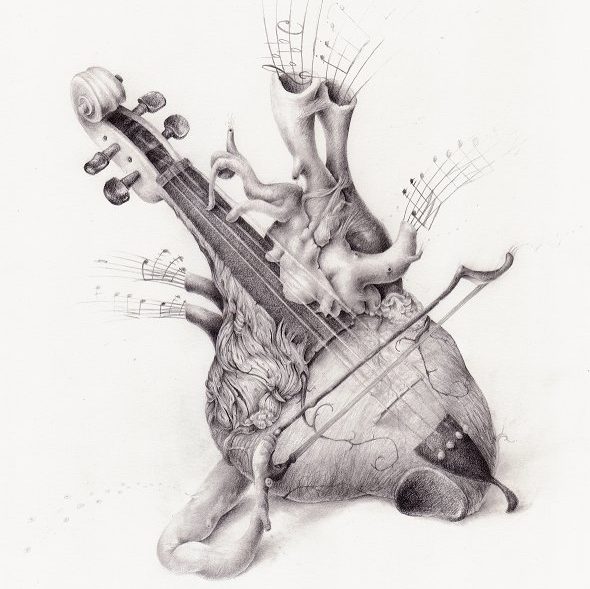When I first ventured into adding color to my artwork, I reached for colored pencils. I didn’t think about my artwork lasting a lifetime or even that people might be interested in buying it, so I reached for Crayola Colored Pencils. All that mattered was that I was having fun, right?

I didn’t know anything about colored pencils at the time, but I quickly found that Crayola was very limited in the number of layers that would go on the paper. After a while, no more pigment would go onto the paper, and instead it was like the pencil was just pushing the pigment around. It left a fogginess over anywhere I’d put down a lot of colors, and I could never get rid of the graininess.
Despite all that, I really enjoyed what I was doing.
Eventually, I thought it might be time to upgrade my pencils. I still didn’t know much about colored pencils, but I’d read on some online forums that Prismacolor was supposed to be the best. At the art store, I balked at the price. I grabbed a 12 set of Koh-I-Noor pencils instead.

I found Koh-I-Noor pencils to be a lot more pigmented than Crayola, but I struggled to get any sort of realism with them. I couldn’t get them to layer the same way that Crayola had, and all the drawings I did with them looked cartoonish. Not that that’s a bad thing, it just wasn’t what I was hoping to achieve. And I was still getting the grainy look with them.
A few years later, I took an art class where we were going to be using colored pencils. Prismacolor was the colored pencil on the supply list. I didn’t know there were different types of Prismacolor pencils, so I grabbed a pack of what was on sale–Verithins.

We immediately got along. I was able to layer so much more than I could with either Crayola or Koh-I-Noor. The way they went down on the paper felt just like my beloved graphite pencils but with pigment! I loved them … mostly.
I never was able to use the black Verithin pencil. The one that came with my first set broke all the way down. I thought nothing of it, must’ve just been a defective pencil. Next time I was at the art store, I grabbed another. That one broke all the way down, too. I purchased another. Same story. That happened with a few of the other pencils as well, never to the same extent, but it was still frustrating. I was paying over a dollar for each pencil, shouldn’t they last for more than one sharpening?!
Another problem was that the colors never became very vivid no matter how many layers I put down. Although, now I did find that as long as I kept them sharpened, I didn’t get the graininess.
I eventually decided to give Prismacolor Premiers a try. Those were the colored pencils I’d read about. Those were the colored pencils that were supposed to be The Best.

We didn’t get along.
Sure, I loved how many colors I had to choose from, but what good are all those colors if they crumbled every other time I sharpened them! I was used to slowly building up my colors, but these laid down so much bolder even with an incredibly light hand. Not that there’s anything wrong with that, it’s just a personality difference.
I was able to create some beautiful pieces with them, but we struggled to ever see eye-to-eye. I wanted softness and subtlety, they wanted to be seen. I wanted a sharp point for details, they just couldn’t hold up. I wanted every speck of the paper covered, they didn’t like filling in the valleys of the paper without a lot of coaxing. Quality problems aside, this pencil just wasn’t for me. I missed the precision and gentleness of my Verithins, but I did love the richness of the Premiers. I wasn’t sure if I’d keep up colored pencils seriously if this was what I had to choose from.

Enter Faber-Castell’s Polychromos. It was love at first drawing. They held a sharp point for precise details and getting down into every valley of the paper. No more grainy drawings! They were precise, subtle, deeply pigmented, and didn’t break every time I sharpened them. They were everything I loved about the Verithins and Premiers combined without any of the drawbacks. Well, there was one drawback. They’re a very translucent pencil. Which is wonderful for layering color on top of color for some lovely effects, but if I want to lay over white or a lighter color on top, it just wasn’t going to happen. Not the end of the world, I’d just have to be far more careful with the areas I wanted to stay white or a light color.
And then I found Caran d’Ache’s Luminance colored pencils. They could add those bright highlights I wanted sometimes. They didn’t break, they were pigmented, they were lovely. Except the price tag. $4 for a single pencil. Because of that, I haven’t gotten the full set yet, but they work wonderfully with my Polychromos.

I am incessantly thought about this, regards for putting up.
With thanks! Valuable information!
Personally, if I’m writing in pencil, I’d favour a 2H wooden one (no preference on manufacturer); for technical drawing only a mechanical pencil will do for accuracy; but a craft knife-sharpened 2B will always feel right for sketching.
I really appreciate your help with my project!
Another thing that you should keep in mind when buying cheap colored pencils is that they may have different shades of color, and may be in a certain size. You can ask the salesperson if you can see a sample of a certain size or color of pencil, so that you can find out how they feel about them.